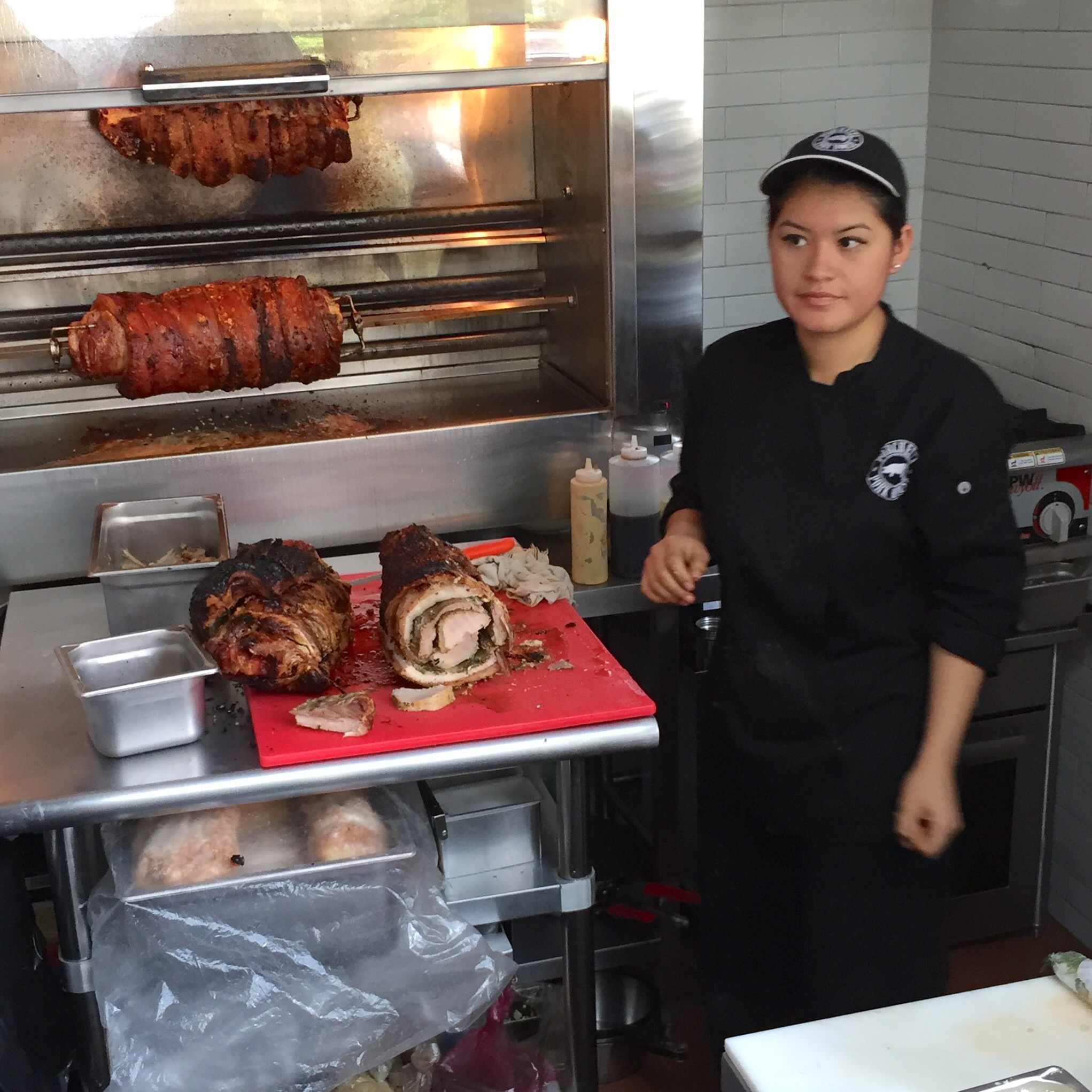Surf & Turf on the Champs-Élysées: Agua y Sal & Porchetta Pork House
A porchetta sandwich; 4 ceviches at Agua y Sal
In tony Polanco, most of the action takes place on or near Avenida Presidente Masaryk, Parque Lincoln or in Polanquito. Quiet and hidden is the tree-lined boulevard Campos Elíseos, which lazily loops along the northern side of Parque Chapultepec. It’s home to the zona hotelera(where Hyatts and Marriotts vie for well-heeled tourists), a few shops and restaurants that aim for swank, and high-rent apartment buildings. Unlike its Parisian namesake, however, this Champs-Élysées exhibits no grandeur. But a pair of surf and turf eateries have recently opened their doors here. Both are worth the trip to this otherwise sleepy side of the zone.
Peru meets Mexico at Agua y Sal
Agua y Sal is a cevichería that looks to South America for inspiration, but doesn’t turn its back on Mexico. Having visited Peru on several occasions, I can speak highly of what chefs, from the revered Gastón Acurio down to vendors in Lima’s Mercado Central, can do with raw fish. The Peruanos are experts when it comes to choosing seafood, creating a subtle balance of briny, sour and sweet in their sauces--and they have perfect timing in the marinating process. They know how to feature the main ingredient with finesse.
Owner Rodrigo Estrada agrees. An avid gastronomist, he studied hotel administration “at a time when it wasn’t hip to be a chef.” After working in Cuernavaca and Playa del Carmen, he was contacted by the great Acurio himself, who beckoned him to Lima. Although Estrada was about to leave on his honeymoon, his understanding wife saw opportunity knocking and encouraged him to go. He was hired to open a branch of Cebichería La Mar, Acurio’s posh but laid back venue in the Miraflores district of Lima, in San Francisco. After studying the inner workings for a few months, Estrada returned to California to inaugurate the new branch. But the La Mar empire was not meant to be - it closed there as did our Santa Fe branch, so he returned to Mexico with an open slate.
Not to waste his newfound knowledge of Peruvian seafood, Estrada inaugurated Agua y Sal shortly after, in 2011. He oversees operations with an eagle eye, choosing fish daily at the Mercado de la Viga or from Sargazo, our best purveyor of goods from Ensenada.
The setting is atypically low key for slick high-design Polanco. Furniture is simple blond wood, set off by cheerful chartreuse walls and grass-green retro patterned tiles floors.
The ceviche menu is divided into four categories: classic, sweet, spicy and original. All are, according to Estrada, “radically different.” I love the Peruano, a classic. Strips of flounder are showered with leche de tigre, the traditional Peruvian milky lime-garlic marinade, and whisked to the table. Acid barely has time to penetrate the fish – “we do it for 3 minutes max,” the chef asserts--so the end result is like Japanese sashimi with a kick. The fish remains the star of the show, not the sauce.
From the sweet section, the ‘Agua y Sal’ is a hit. It blends shrimp, mango, pineapple, chile cuaresmeño, cilantro, peanut and sesame oil—Mexico meets Thailand. It all works together magically, nothing cloys.
A standout from the spicy menu is callo de hacha, close to our familiar aguachile; the liquid in which scallops swim is tart and piquant. The heat is high, but salty/sweet/sour/umami are balanced.
A curiously named Cubano, an “original”, is a clever blend of chocolata clams, shrimp and octopus in calamari ink, with red onion, cilantro, chile jalapeño, chile puya, Worcestershire sauce and ‘Sal Negra de Chipre’. None of these ingredients are found on the eponymous island, or have been since 1959, so its name remains a mystery. The degustación de ceviches offers a choice of four, and at $225 pesos it’s an economical choice.
The menu also includes raw oysters and clams, tostadas, tacos and other sea-oriented antojitos. I enjoyed the plancha de frutos del mar in which assorted seafood and fish are sautéed with garlic and served with a side of Portobello mushrooms and green onions. There are a couple of pasta dishes, also a fishburger that comes with sweet potato and fries. All are fine, but the ceviches take home the prize. Agua y Sal gives the already famous Contramar across town a run for its money. It’s definitely a contender for the best purveyor of sea fare east of Baja.
Agua y Sal
Campos Elíseos 199A, Polanco; view map
Tel. 55 5282 2746
Open Monday – Saturday 12 10 p.m., Sunday until 6
Pigfest at Porchetta Pork House (CLOSED 2018)
We love our pork in Mexico, where cooks know how to do it right. Carnitas, those divine little morsels of confit, merit Unesco recognition. Pork belly is everywhere, we have great chorizo, juicy chuletas, beautifully smoky bacon that stands up well to the Canadian. But so far no one had thought to do porchetta, a classic Italian preparation almost as old as the Seven Hills of Rome. So that’s why Rodrigo Estrada, inspired by a successful food truck in San Francisco, opened his Porchetta Pork House down the street from his cevichería.
Porchetta (pronounced a la Italiana, with a hard ‘k’ sound on the ‘ch’) is, as trusty Wikipedia tells us, “a savory, fatty, and moist boneless pork roast of Italian culinary tradition. The body of the pig is gutted, deboned, arranged carefully with layers of stuffing, meat, fat, and skin, then rolled and roasted, traditionally over wood. Porchetta has been selected by the Italian government as a prodotto agroalimentare tradizionale (traditional agricultural-alimentary product).” It’s popular all over Italy but most associated with the Lazio region around Rome.
Porchette roasting
At his cosy locale housing a few tables, roasters open to the street, Estrada has sourced the very best pork from a farm in Michoacán. His chefs use the pancetta (aka pork belly) onto which they rub sage, rosemary, dill, ginger, peperoncini, garlic, lemon zest, seas salt and pepper. The whole thing is wrapped around pork loin, tied up, roasted on a spit in a wood-fired oven and then sliced. It is served as a paninno on a Catalan-style roll, similar to those used for pa amb tomaquet, which are provided by artisan baker Joan Baguer’s Sal y Dulce. The bread is crunchy and light, the meat smoky, aromatic and succulent. Some pickled onions add a complementary note of acidity. And yes, it’s as good as it sounds.
A side of potatoes, an accompaniment advisable only for the most rapacious of diners, is flavored with meat drippings, and makes lunch anything but light. But they taste very good so are quite irresistible. While several gussied-up variations of panini are offered on the billboard menu, the clásica is the wisest choice – why mess around with a good thing?
In a town already rife with porcine options, this house stands alone and is well worth a visit. It’s Pig Heaven on the Elysian Fields.
Porchetta Pork House
Campos Elíseos 247, Polanco; View map
Tel. 55 6840 0588
Open Sunday, Monday 12 - 6 p.m., Tuesday, Wednesday 12 – 12, Thursday-Saturday until 2 a.m. http://www.porchetta.com.mx/








